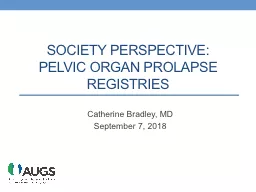

Prolapse Registries Catherine Bradley MD September 7 2018 Outline Background Pelvic Organ P rolapse Background Mesh in POP Surgery AUGS Registry Experience the Pelvic Floor Disorders Registry PFDR ID: 790255
Download The PPT/PDF document "Society Perspective: Pelvic Organ" is the property of its rightful owner. Permission is granted to download and print the materials on this web site for personal, non-commercial use only, and to display it on your personal computer provided you do not modify the materials and that you retain all copyright notices contained in the materials. By downloading content from our website, you accept the terms of this agreement.
Slide1
Society Perspective: Pelvic Organ Prolapse Registries
Catherine Bradley, MD September 7, 2018
Slide2OutlineBackgroundPelvic Organ Prolapse
– BackgroundMesh in POP SurgeryAUGS Registry Experience – the Pelvic Floor Disorders Registry (PFDR)
Accomplishments
Lessons learned
POP research
questions
Slide3What are pelvic floor disorders (PFDs)?
Interrelated clinical conditions:Pelvic organ prolapse (POP)Urinary incontinence (UI)Fecal incontinence (FI)Emptying abnormalities of the lower urinary and GI
tracts
Almost 25% of all women and more than 1 of 3 older women report symptoms of at least one
PFD
(Nygaard, JAMA 2008
)
1 in 7 women will undergo POP surgery by age 80
(Wu,
ObGyn
, 2014)
Slide4Pelvic Organ Prolapse (POP)Descent of the pelvic organs into or through the vagina
Often accompanied by:Vaginal bulgingUrinary symptomsBowel symptomsSexual dysfunction
3
%-6% of
women have POP (vaginal/uterine descent) beyond
the
vaginal opening
15-17% of all hysterectomies done for POP; most common indication for hysterectomy in postmenopausal women
Slide5POP TreatmentNon-surgicalObservation, Behavioral modifications
Pelvic floor muscle exercisesPessarySurgicalTransvaginal
Native tissue repair
Transvaginal
Mesh
Abdominal or Laparoscopic/Robotic
Sacrocolpopexy (includes mesh)
Obliterative (vaginal closure or colpocleisis)
Slide6POP Repair Surgeries - US Market 2010*
300,000 women
*industry source
Slide7Transvaginal Mesh - Events
2008
FDA Public Health Notification
2008
AUGS
began
exploring development of POP registry
July
2011
FDA Updated
Safety Communication
on Transvaginal Mesh
for POP
Sept 2011 FDA Advisory
Panel convened
Nov 2011 AUGS Strategic Planning Meeting – POP
registry
development high priority for Society
Jan 2012 522 Orders
Slide8Surgeons performing transvaginal placement of mesh for POP should undergo training specific to each device and have experience with reconstructive surgical procedures
and a thorough understanding of pelvic anatomy.Transvaginal placement of mesh for POP should be
reserved for high-risk individuals in whom the benefits of mesh placement may justify the
ri
sk...
ACOG & AUGS strongly support continued audit and review of outcomes, as well as the
development of a registry for surveillance for all current and future vaginal mesh implants
.
Slide9Transvaginal Mesh/FDA
Jan 2012: FDA
ordered
postmarket
surveillance studies (
“
522 studies
”
) by manufacturers of urogynecologic surgical mesh
devices
RCT
or prospective cohort recommended with comparison to transvaginal surgery without mesh (
“
native tissue
”
)
Amenable
to facilitating multi-sponsor
registry
Slide10POP Outcomes Registry - Development
Collaborative effortAUGS registry leadership and experts on content, research design, and implementation
Industry partners, FDA, NICHD, ACOG, Women’s Health Registry Alliance, PFDN Advisory Panel, SUFU, AUA
Consensus on data collected
Outcomes
Shared native tissue control group
Shared non-surgical group
Slide11What is the PFDR?Multiple POP treatment registries/databases
Designed to
collect prospective data
from patients
undergoing treatment for pelvic organ prolapse (POP)
Intended to collect both provider and patient reported
outcomes
Slide12PFDR
Objectives
Evaluate
effectiveness
,
QOL and
safety
of POP surgery
Assess
effectiveness
and
QOL associated
with non-surgical management (pessary)
of
POP
Provide a framework for clinical studies to be conducted within the registry, including industry-sponsored studies required to fulfill the FDA
’
s request for
postmarketing
surveillance for transvaginal mesh for
POP
Allow surgeons to track
patients, outcomes, adverse events,
q
uality measures
Slide13What did we accomplish?
DevelopmentData Access/Legal AgreementsCommon core dataset and
protocol
Shared native tissue
group
Common primary outcome, adverse outcomes
~700 common data elements
Functioning database
Scope
4
Industry
Partners: 7 protocols (522)
AUGS Quality and Research protocols
Slide14PFD Registry -
Timeline
Legal agreements - 2012
D
ata
collection and database requirements
2012-2013
User
acceptance testing
2013
Launch
Industry protocols 2014
AUGS quality/research protocols 2015
Slide15PFDR – Current Stats
4 active Industry protocols1 active AUGS Research protocolEnrollment ended, 3-year follow-up ongoing> 700 total PFDR sites> 3500 total PFDR participants
AUGS Research Registry
11 active sites
1,159 participants
820 Surgery
339 Pessary
Slide16PFDR Challenges - DevelopmentCollaboration of “Rivals”
Making a Registry Platform also function/meet requirements for a pre-market approval study9 protocols (7 industry-sponsored, AUGS research, AUGS quality)Thousands of volunteer hours
Slide17PFDR Challenges – Use, LongevityDouble data entry
Difficult/costly to make changes in platformMaximizing patient participation Long-term patient follow-upLong-term funding
Slide18POP Registry PlanningMore focused objective for POP core minimum datasetDevice effectiveness, safetyQuality measure requirements
Opportunity for modular expansion Research questions that require more detailed data collectionChanges in device indications
Direct data collection from electronic medical record
User-friendly platform
Slide19High Priority POP Research QuestionsSurgical factors:
Does a concomitant hysterectomy impact outcomes?Are native tissue repairs really equivalent to mesh repairs in terms of durability?
When
is an apical prolapse repair absolutely necessary?
Patient factors:
What patient factors will modify risks and recurrence rates?
What outcomes best match the patient experience
?
Surgeon factors:
Does
fellowship training make a difference in
outcomes
?